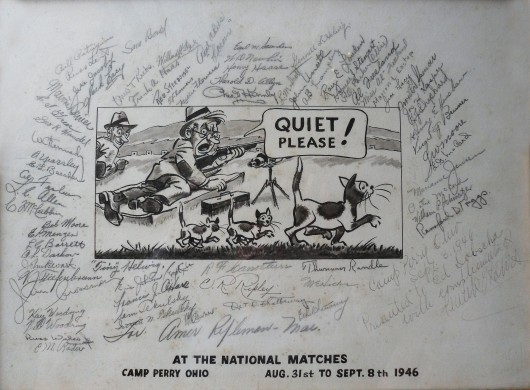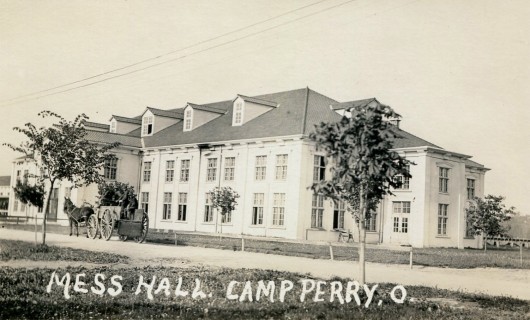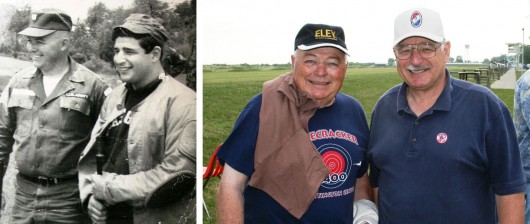2012 NRA FOUR POSITION OCEAN STATE SECTIONALSanctioned by the National Rifle AssociationSponsored by the Rhode Island Rifle and Revolver AssociationHosted by the Smithfield Sportsmen’s ClubThe NRA National Open Indoor Championships give competitors a chance to compete in a national event by comparing their scores with those fired by competitors in clubs all over the country. Scores are comparable because of the similar conditions existing in indoor ranges. Competitors and sponsors are responsible for the content of this program (Rule 18.2).NRA will conduct National Open Indoor Rifle Sectionals starting January 1, 2012 and concluding on March 21, 2012. All results must be at NRA no later than April 2, 2012. Any results received after the closing date will not be included in the 2011 National Indoor Championships Bulletin.The 2012 National Open Indoor Rifle Championships are determined by scores fired at local Sectional Tournaments, which are compiled at NRA Headquarters. A bulletin showing National Award Winners and a complete listing of all competitors and their scores is compiled and the official results are available at:www.nrahq.org/compete/champ1.asp.I. GENERAL CONDITIONSLOCATION: Smithfield Sportsmen’s’ Club,
DATE: March 4, 2012CONTACT: Hap Rocketto, 18 Stenton Ave., Westerly, RI 02891 or 401-322-7193 or hrocketto@cox.net.TIME: Relay One at 8AM, Relay Two at Noon with Team Matches to be fired at the conclusion of individual relays.FEE: Package fee of $10.00 for individual entries and $5.00 for teams.RULES: Current NRA Rifle RulesDISTANCE FIRED: Fifty FeetRIFLE: Rule 3.2SIGHTS AND TARGETS: Any Sights; NRA Official A-17 TargetINDIVIDUAL ENTRIES: Open to Adults and Juniors (NRA membership is not required.)MATCH SCHEDULE:All matches/positions must be fired in the sequence indicated below.MATCH 1: Individual Match – 20 shots, prone – 20 minutes.MATCH 2: Individual Match – 20 shots, standing – 30 minutes.MATCH 3: Individual Match – 20 shots, sitting – 20 minutes.MATCH 4: Individual Match – 20 shots, kneeling – 20 minutes.MATCH 5: The Sectional Individual Championship (an aggregate of matches 1, 2, 3, and 4).MATCH 6: The Sectional Team Championship – 10 shots prone, 10 shots standing, 10 shots sitting, and 10 shots kneeling. The same position rules as individual matches apply in this fired match.MATCH 7: National Individual Championship.MATCH 8: National Team Championship.There is no entry fee for Match 7 & 8. The entry is automatic with entry in Match 5 & 6 of each Sectional Tournament. Scores from Match 5 & 6 will be used for this Match.FIRING REGULATIONS FOR MATCHES:Since Sectional scores are to be used to determine National Champions, all Sectionals MUST be conducted in the prescribed manner.1. Individual matches: If range facilities permit, two targets for the match should be mounted simultaneously, and an additional three minutes will be allowed for target change of the second stage or match as needed. When only a single target is mounted, due to range limitations, three (3) minutes for each target change will be added to the total firing time for the match.2. Sighting Shots: Unlimited number may be fired any time3. Shooting Time: Time allowed includes sighting shots. Time remaining from one position may not be carried over to a following position regardless of the method of changing targets.4. Firing Order: All matches must be completed by all competitors on a relay before the next match is started. Matches must be fired in the order identified in each of the program sections.5. Preparation Period: After record targets for a relay have been properly mounted, a three (3) minute preparation period will be given before the “Commence Firing” command.6. Target Height: Target height may be adjusted.SCORE CARDS: Special score cards will be used and must be signed by the competitor to be considered for the national bulletin. If no category is circled, a competitor or team will be placed in the Civilian category. If no classification is circled, a competitor or team will be placed in the Master class.CATEGORIES: As identified in each program section.CLASSIFICATION: Each individual competitor will be placed in one class according to the NRA Classification System and shall be prepared to exhibit his classification card or Temporary Score Record Book. Unclassified competitors will fire in the Master Class classification (Rule 19.6). Teams will be classified according to rule 19.12.SOUVENIR PINS: Each competitor firing in the Sectional Tournaments will be given a souvenir pin by the sponsor. Pins are provided by NRA.CHALLENGES: A challenge fee of $3.00 will be charged for each challenge made. See Rule 16.1 for correct procedure.TEAM ENTRIES: Team participation should be indicated on individual entry card. Team entries must be made in person at the Statistical Office.ENTRIES CLOSE: Individual match entries must be received no later than the Monday preceding the opening date of the tournament. Team match entries may be made any time prior to the start of firing the team match.POST ENTRIES: Post entries will be accepted up to the capacity of the range provided such entries will not require extra relays.SIGHTING SHOTS: Unlimited sighting shots will be allowed in all matches and at all stages and must be taken within the time limit (Rule 8.2).SQUADDING: Will be assigned by the sectional Statistical Officer. Please state preferred time of firing. Teams are not required to be squadded together to fire as a unit. Additional relays not identified in the sectional program must be coordinated with and approved by the National Statistical Officer. A Match Directors Bulletin announcing the additional relay and NRA approval must be posted on the Official Bulletin Board.ELIGIBILITY: A competitor (individual or team) may enter more than one Sectional tournament of each kind in 2011. However, the individual MUST declare before firing if the Sectional being fired is for score only or for the National Championship. If firing for score only the score card must be marked according. Competitors may enter other types of Sectionals if eligibility limitations permit. Competitors entering for “score only” are NOT eligible for awards in the local sectional or the National Championship. A foreign competitor is eligible to participate in the Sectional and National level (Rule 2.1.1), however, only U.S. citizens may win the First, Second and Third Place National Individual and Team Championship awards. A special high visitor award will be given.NRA SMALLBORE RIFLE DISTINGUISHED AWARD: A leg toward the NRA Smallbore Position Distinguished Award can be earned by winning a place in the top scoring 10% on the national level.NATIONAL 4-POSITION OPEN INDIVIDUAL CHAMPIONSHIP AWARDSMATCH 7 National Individual ChampionshipProvided by: The National Rifle AssociationWinner: National Championship Medallion, Lister Plaque, and 50 NRA award points.Second Place: Silver National Championship Medallion and 40 NRA award pointsThird Place: Bronze National Championship Medallion and 30 NRA award pointsWoman Champion: Sea Girt Trophy PlaqueSenior Champion: NRA Special AwardA High Visitor award will be given to any non-US citizen who places first, second, or third overall.CLASS AND CATEGORY AWARDS:Separate class awards will be given in each of two categories – Civilian and Service. Awards will be given in all categories in Master, Expert, Sharpshooter, and Marksman classes.First Place: 10 NRA award points with at least 5 competitors in class and categorySecond Place: 8 NRA award points with at least 10 competitors in class and categoryThird Place: 6 NRA award points with at least 15 competitors in class and category.Three NRA award points in each class of each category will be given for each 5 entries or major fraction thereof in a class over 15.Juniors who have indicated on their entry card that they do not wish to receive award points will NOT receive substituted awards.NATIONAL 4-POSITION OPEN TEAM CHAMPIONSHIP AWARDSMATCH 8 National Team ChampionshipProvided by: The National Rifle AssociationWinning Team: 5 National Club Trophy Plaques2nd Place Team: 40 award points3rd Place Team: 32 award pointsCLASS AND CATEGORY AWARDS: Separate class awards will be given. Category awards will be provided in the 4-Position. Awards will be given in the Master, Expert, Sharpshooter, and Marksman class in each category.First Place: 20 NRA award pointsSecond Place: 16 NRA award points with at least 10 teams in class and category.An additional place, 12 award points, in each class of each category will be given for each 5 teams or major fraction thereof over 20.DIRECTIONS: I-295 North or South to Exit 7B US 44/Putnam Pike, turn right onto Cedar Swamp Road/RT 5, third right onto Walter Cary Road, club will be on your left.
FOOD: There will be no food service available.
Support pronematch.com
If you value the information that pronematch.com provides, please consider making a $10 donation to support this site.-
The Latest Posts
Site Search
Categories
Recent Comments
- Caitlyn Constant on Canadian Airgun Grand Prix
- ✉️ Unread Notification - 1.95 BTC from user. Review funds => https://graph.org/ACTIVATE-BTC-TRANSFER-07-23?hs=c4009ae0d9dd5831a89ca58d16f747ca& on THERE IS NO ROYAL ROAD…
- Unread Message: 1.95 BTC from user. Review funds => https://graph.org/ACTIVATE-BTC-TRANSFER-07-23?hs=f90541f90e7f9c5d2db519f0da3fc829& on The USS RUMFORD…
- Incoming Message: 0.45 Bitcoin from exchange. Claim funds >> https://graph.org/ACTIVATE-BTC-TRANSFER-07-23?hs=170c09d955a12f76695128c8370d564d& on THE RIGHT STUFF…
- Unread Notification - 1.95 Bitcoin from user. Claim funds > https://graph.org/ACTIVATE-BTC-TRANSFER-07-23?hs=163aee07dd09eb70fa21e1667c5b45fd& on THE GODFATHER OF SHOOTING KNOWLEDGE?…






